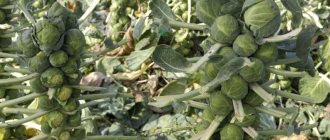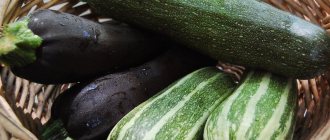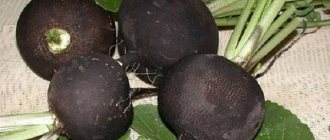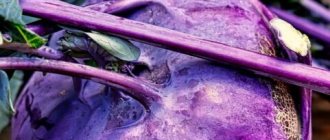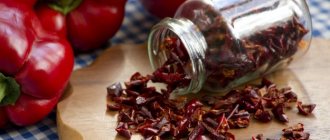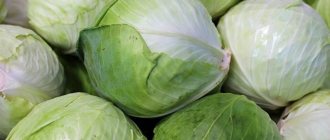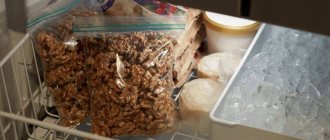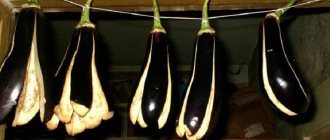In our articles, we have already talked in detail about ways to store bell peppers, in particular about drying them at home and freezing them in the freezer. Today we will talk about red hot pepper and how to store it. How to preserve hot peppers for the winter at home?
How to choose peppers for storage
Hot peppers can be stored fresh in a cool place for up to several months . To preserve this vegetable at home for a longer period, use the following storage methods:
- freezing;
- drying;
- canning.
Regardless of which option for preserving the beneficial properties of the product is chosen, the fruits for storage are selected in the same way.
They must be ripe and without external defects (dents, cracks, rot). It is preferable to take a mid- or late-ripening vegetable variety for harvesting . Fleshy, thick-walled pepper varieties are more suitable for freezing and canning, while thin-walled varieties are more suitable for drying.
For example, the fruits of the varieties Burning Bouquet, Dragon's Tongue, Indian Elephant, Astrakhan 147, Chili are recommended for drying, and the varieties Miracle of Moscow, Ogonyok, Vizier and Double Abundance are recommended for freezing and canning.
Methods for drying pepper seasoning for the winter
In the oven. With patience and plenty of time, you can dry the pepper well in a conventional gas or electric oven. The collected pods need to be washed and dried. Some cut the pods lengthwise into halves or quarters, removing the stems, while others dry them whole. The prepared peppers should be laid out in one layer on a baking sheet lined with baking paper. Place in an oven preheated to 50°C, leaving the door slightly open. With such ventilation, the pepper will not bake, but will dry out.
On a string. This is a simple, “old-fashioned” way of drying peppers. You can dry mushrooms and apples in the same way. The main thing is to choose a warm, well-ventilated place where the air is not at all humid. Wash the peppers, dry them, and then use a needle to string them by the stalk onto a thick and strong thread. Then fasten both ends of the thread in the chosen place (this could be a balcony, loggia, etc.) and at the desired height. The pods need to be distributed on the string so that they do not touch each other. This way they will dry evenly on all sides.
On the window. This simple drying method is suitable for those who have wide window sills. They need to be covered with clean paper (parchment), washed and dried hot peppers should be laid out (can be cut into slices), covered with thin paper on top (to protect from dust) and the pods should be left to dry for 2-3 weeks, stirring/turning them from time to time.
Drying
Dried pepper does not lose its pungency and pungency. Dried fruits can be stored for up to several years .
On air
You can air dry hot peppers either in pieces or whole . Housewives often prefer to dry peppers without damaging the integrity of the fruit. Peppers are collected in bunches, tied with twine or threads by the stalk and hung to dry in a cool, dry, ventilated place.
Drying takes about 1-2 weeks . Bundles are subsequently used not only for culinary purposes, but also as interior decoration for the kitchen or home.
Attention! When drying, the fruits should not be exposed to direct sunlight. Their intensity is difficult to control; they can “wither” the pulp too quickly and spoil the product.
Hot pepper, ground. We do it ourselves.
In the oven
Hot peppers dry faster in the oven than in air. The whole process takes from 2.5 to 5 hours.
To dry the pepper, preheat the oven to 40-50°C . Cover the baking sheet with parchment paper and place clean fruits (whole or cut) on top. They are turned over every 30 minutes to ensure even drying.
Attention! When working with hot peppers, it is advisable to use gloves. To avoid getting pepper on your mucous membranes, do not touch them with your hands. After handling fruits, wash your hands thoroughly with soap.
In an electric dryer
In an electric dryer, peppers will dry out faster than in an oven. Depending on the drying power and the thickness of the fruit walls, a product ready for storage can be obtained within 1-2 hours.
Peppercorns, whole or in pieces, are laid out on drying tiers , then the device is plugged into the mains. The tiers are swapped every 15 minutes. Dry pods are placed in a glass jar.
One of the common ways to store dried pepper is to grind it into powder (twist it in a meat grinder), put the ground mass in a sterile glass jar and put it in a dry place (optionally in the refrigerator).
Attention! The ground mixture will retain its pungency for about a year, and after that the burning taste will begin to disappear. It is not advisable to store the mixture longer - the taste will deteriorate.
Preparation
How to prepare hot peppers for long-term storage? Red hot pepper is everyone's favorite. It is what gives a special piquancy to any dish , and can easily become an excellent addition to any meal. Red pepper is used in cooking, in making sauces, and also as an independent seasoning .
It's no secret that red peppers keep well for a long time.
But our task is to preserve the vegetable during the winter so that it can delight us not only with its pleasant taste, but also with its properties .
Pepper is a type of fruit that does not need to be prepared for consumption.
That is, you just need to wash the capsicum and dry it a little from moisture, and the preparation is complete.
But some types of conservation and storage still require a different approach. If you don't want the pepper to become even more bitter by the time you decide to eat it, you will have to remove its seeds . They are the ones who contribute to the appearance of bitterness.
A quick and easy way to remove seeds from red peppers in this video:
Also remember that properly prepared peppers must be thoroughly washed . Insects, rain, soil residues - all this should not remain on the vegetable.
The best way to wash peppers is to place them for a few minutes . During this time, pieces of dirt, harmful microbes and bacteria will come off the surface.
Then the pepper must be rinsed with cool water and dried with a towel.
If the recipe requires, cut the pepper lengthwise into two parts and scrape out the seeds. After this, the hot pepper is ready for subsequent preparations.
Freezing
Unlike drying, in which the pungent pods are often processed whole, when freezing the fruits are usually crushed . They are cut so that the size and shape are suitable for cooking.
Some housewives remove the seeds from the fruit when freezing hot peppers.
Reference. The hotness of hot peppers comes from the alkaloid capsaicin contained in the fruit. Most of it is in the seeds, inner walls and peel of the fruit - these parts are the hottest.
But there are those who prefer to preserve the sources of pungent taste and freeze the vegetable, cutting it along with the seeds.
The sliced fruits are placed on the tray in a loose layer, avoiding touching the slices . After a few hours, when the vegetable is frozen, the slices are transferred to a plastic bag or containers and stored in the freezer. Before freezing, shake the bag(s) to separate the pieces from each other.
At a storage temperature of minus 18-22°C (optimal mode), the vegetable can be stored for up to six months without any problems.
Uses frozen product in the preparation of soups (borscht, kharcho), stews, goulash, stewing and for preparing savory sauces.
It can be useful:
The benefits of cayenne pepper and how to grow it correctly
What is good about the Ogonyok pepper variety and how to grow it
Harvesting a fragrant pepper harvest
Typically, peppers are collected selectively, once or twice a week, as they are ready. Total harvesting is carried out only when there is a threat of frost, which this crop cannot tolerate at all. The calendar dates for the start of harvesting largely depend on where the plants are grown - in a greenhouse, hotbed or open ground.
The finished fruits should be cut extremely carefully, with the stalk intact, so as not to damage the very fragile branches. It is best to use a special pruner or scissors for this purpose.
To store sweet peppers, it is necessary to select healthy fruits that are not damaged. The easiest way to do this is to spread the pods in a thin layer in some cool and well-ventilated area, such as a basement. After about a week, sick and weakened specimens will definitely manifest themselves - they will begin to rot.
For disinfection, it is recommended to treat healthy peppers with copper sulfate - just dip them in a one percent solution and then dry them directly in the air. It is most convenient to store them in boxes with a capacity of no more than 10 kg, which can be either wooden or made of other materials. The walls and bottom can be lined with wrapping paper, or you can wrap each pod in it separately.
If the temperature in the basement does not exceed 10 °C and the humidity is between 90 and 95%, the fruits will ripen within a month. Then you should lower the temperature to zero degrees - this will extend storage for another two months.
Preserving
There are many ways to preserve hot peppers . Pepper rolls can be stored for up to one to two years in a cool place. Let's dwell on the most favorite recipes among gourmets.
With vinegar and honey
Hot peppers are washed and placed tightly in a sterile liter jar . Fill with boiling marinade to the top, roll under a metal lid, turn upside down and cover with a “fur coat” until it cools.
Composition of the marinade:
- 5 tbsp. l. honey;
- 3 tbsp. l. salt;
- 400 g vinegar (9%);
- 1 bay leaf;
- 5 black peppercorns.
With oil and vinegar
The preparation technology is standard : clean, dried fruits are compacted into a sterile glass jar. A few cloves of garlic are also added there. Everything is poured with boiling marinade and rolled under the lid.
Mix for marinade:
- 200 g vegetable oil (refined, deodorized);
- 250 g water;
- 200 g sugar;
- 1 tbsp. (with top) salt;
- 200 g vinegar (9%).
Advice. As additional ingredients for marinating, you can add dry spices, coriander, fresh parsley or celery to the recipe at your discretion.
In Georgian
To prepare the dish you will need:
- 5 kg of hot pepper;
- 300 g garlic cloves;
- one large bunch each of parsley and cilantro;
- 500 g vegetable oil (refined, deodorized);
- 1 liter of vinegar (9%);
- 7 tbsp. l. salt;
- 6 tbsp. l. Sahara;
- 8 bay leaves.
A marinade is made from oil, water, sugar, salt and vinegar . Boil the peppercorns in it for 5-7 minutes, then take them out and let the brine drain.
The fruits are placed in jars. Garlic and herbs are minced in a meat grinder, the mixture is added to the marinade and brought to a boil. Jars with fruits are poured with boiling marinade and sterilized in a water bath (0.5 liter jars - 9-10 minutes, 1 liter jars - 18-20 minutes). Then the jars are rolled under the lids. Store the snack in a cool place.
In Armenian
Scald clean fruits in boiling water for about one minute , remove with a slotted spoon and immediately plunge into cold water. As a result of a sharp temperature change, the top skin will begin to separate from the fruit - remove it. Then the pepper is boiled for 1-2 minutes in the marinade and placed in sterile jars mixed with garlic cloves.
Next, fill it with boiling brine and roll it under metal lids. The jars are turned upside down and wrapped until completely cool. Store the workpiece in a cool place.
Composition of the marinade:
- 1 liter of water;
- 70 g vinegar (9%);
- 350 g vegetable oil (refined, deodorized);
- 70 g sugar;
- 3 tbsp. l. salt.
Canning
To diversify the winter menu with canned food with excellent taste, hot peppers are canned or pickled. The main advantage of this method is the ability to fantasize and experiment by adding different amounts of spices, salt, and sugar.
To preserve peppers for the winter, you can use the following recipes:
Marinade with vinegar
Sterilize a 1-liter glass jar and fill it with chopped peppers.
Boil vinegar (400 ml) in a separate pan, add salt (3 tablespoons), sugar (5 tablespoons), black pepper (10 peas). If desired, you can add bay leaf and fresh herbs.
Pour the hot marinade over the vegetable, leaving about 1.5 centimeters of space free. Roll up and place upside down to cool, covering with a warm blanket on top.
Garlic marinade
Place the chopped pepper in a sterile container, add a few chopped cloves of garlic, bay leaf, and herbs on top. Dissolve 50 ml of vinegar, sugar and salt to taste in 400 ml of boiling water, pour into a jar and roll up.
Western way
Wash and remove seeds from 1 kg of hot pepper, cut into slices. Prepare a marinade from 1 liter of water, 250 ml of vinegar, 3 tablespoons of salt and 6 tablespoons of sugar, pour into a jar and leave for 12 hours.
During this time, the pods will absorb the marinade. After this, you need to top up the brine, add 1 aspirin tablet to a liter jar and roll it up.
In oil
Peppers can be preserved for the winter with the addition of olive or sunflower oils. This method allows you to preserve all microelements and consume the vegetable for 3-4 months.
The washed pods need to be cleared of seeds and cut into slices, placed in a glass container and filled with warm oil. Reserving the seeds will give the pepper a sharper flavor.
It is recommended to infuse the vegetable for 2 weeks in a jar closed with a plastic lid. There is no need to add spices with this method; salt is optional. After this, the pepper is ready to eat.
Secrets and tips
Experienced housewives share the secrets of preparing hot pepper preparations and give useful tips:
- to give the prepared dish a slight spicy spiciness, add not raw or dried chili to the dish, but canned one - the heat of the dish will be softened;
- so that when canning the pepper is better saturated with the marinade and there are no air voids left in the jar, prick each pepper with a toothpick or knife in several places;
- When freezing fruits, it is advisable to release all excess air from the bag. This will save valuable space in the freezer;
- peppers can be pickled together with other vegetables (for example, cucumbers, tomatoes). But keep in mind that the heat of the pepper will spread to the entire contents of the jar.
How to collect correctly
Red hot peppers can be purchased from the market during the peak summer season. Gardeners who grow this vegetable on their own can save money and instead harvest the burning pods in their own garden. Red peppers are picked at the stage of not technical, but biological, full ripeness. The pod should be completely red.
This color means that the vegetable has accumulated a maximum of nutrients.
It is better to harvest in dry, sunny weather. Peppers should be carefully inspected and fruits affected by mold, rot or insects should be discarded. The pods are picked along with the stalks. Then the vegetables are brought to the kitchen and thoroughly washed to remove dirt. Those who don’t like the hot taste of peppers can pour boiling water over them and remove the seeds. True, it’s better not to do this. After all, this vegetable is valued precisely for its pungent and fiery taste.
Let's sum it up
Hot pepper has many fans. So that you can enjoy its taste not only in summer or autumn, when it ripens in the garden beds, the vegetable is prepared for long-term storage. To do this, culinary experts have come up with several ways - dry, marinate, pickle or freeze the vegetable.
Try preparing hot peppers according to our recipes. It will take a little effort, but the result will please you and your loved ones. Bon appetit!
Hot peppers, pickled for the winter. The simplest recipe / Acı biber turşu
About the benefits of hot pepper
Hot peppers have the ability to resist the aging process of the entire body. This vegetable can also prevent the development of cancer. Hot peppers are recommended to be used to prevent the development of cancer cells. Doctors recommend eating pepper for people who suffer from atherosclerosis. It will be useful to eat this vegetable for rheumatism, gout, polyarthritis and myositis. An ointment containing hot pepper is recommended for use during catarrh of the upper respiratory tract, as well as frostbite. In addition, it will help in the treatment of radiculitis, arthritis and rheumatism.
Latest articles about gardening
Caring for a climbing rose in autumn
Sheltering roses for the winter in the Moscow region
Hot pepper is used for cosmetic purposes. For example, you can prepare a mask for aging skin or a tincture to improve hair condition.
Hot peppers have been shown to promote the production of endophrins, which can reduce pain and stress.
In a refrigerator
Hot capsicums can be stored in the refrigerator after washing and removing the seeds. In the refrigerator without freezing, the pods remain fresh for about 2 weeks.
A sterilized jar is usually used as a storage container.
Depending on the desired result, you need to choose a recipe. You can add garlic and onion to the capsicum. To marinate the pepper, it is recommended to pour boiling water over it and close the lid.
A popular way to store pepper in the refrigerator is to place it in ground form in a jar. Provided that dry and sterile containers are used, the vegetable will not begin to lose its beneficial properties or rot during storage in the refrigerator.
Benefits and contraindications for eating chili
Hot peppers are successfully used in cooking, cosmetology and medicine. Valuable properties of chili:
- Rich in vitamin C (even more than citrus fruits - champions in ascorbic acid content, as is commonly believed). Vitamin C strengthens the walls of blood vessels, increases the body's resistance to infections and facilitates the course of ARVI.
- Hot pepper also contains vitamins B1, B2, phosphorus, sulfur, calcium, potassium and other beneficial substances, strengthens the immune system.
- Chili has an antimicrobial and bactericidal effect.
- With moderate consumption of hot pepper in dishes, gastric secretion improves, a laxative effect appears and the healing processes of inflammation in the gastrointestinal tract are accelerated. The substance capsoicin plays an important role.
- If you regularly consume about 6-10 mg of chili in food, your metabolism improves and the process of getting rid of visceral fat (on the stomach and waist) is facilitated. Weight loss occurs gradually.
- Capsoicin in hot pepper has a local distracting, analgesic effect. Ointments and patches based on this substance are used for pain in muscles and joints.
- Hot pepper tincture, if regularly rubbed into the scalp, accelerates hair growth and improves the metabolic process in cells.
- Chili pepper reduces the need for salty foods, which means it indirectly helps normalize blood pressure and reduce swelling.
